Image, Displacement, Aesthetic
Preface
This is the first of two projects that my friend Vrinda Sexaria solicited my participation in. As part of her MA in Photography & Urban Cultures, Goldsmiths, London, Vrinda shared a set of 11 of her photographs, inviting friends’ and acquaintances’ views .
To deliberate on images, to engage in writing, to be invited for collaboration; the opportunity was very exciting for me as it offered, even if in an indirect way, fulfillment of my visual, textual & collaborative predisposition. Excited to the extent that I remember making notes during a train journey to an architectural site.
It has nearly been a decade since I wrote the short essay. As is with most of my writings to date, there are no citations. Although not a formal research, the writing has allowed me an honest meditation, investigation & expression of the subconscious processes at play while I am engaging with images.
Siddharth, 200414
Image Aesthetic: Displacement and Engagement
Framework
Prevalent systems of productions are designed and run around profit and are only concerned with the proliferation of consumer base. All aspects of societies – governance, economy, education, healthcare, communication and so on – are straight jacketed with the principle parameter of popular approval, perpetuating fragmentation of cultures. What is the learning curve between the bipolarity of ‘likes’ and ‘dislikes’? Nothing more than a straight line I believe. Instead, learning occurs through debate and digression. Every work or idea is an exploration and expression at once; and, hence, part of a continual process, no matter how limited its accessibility may be.
Having stated the necessity to delve upon an idea or work beyond one’s likes and dislikes, it demands the setting up of a framework of evaluation and statement of operational definitions of the constituents of the framework to further the deliberation. Art offers an aesthetic experience: a simultaneous and heightened physical, emotional and intellectual engagement; as opposed to anesthesia, which makes an experience subdued, fragmented or disproportionate in its parts.
By this definition, photography must transcend the documentational mandate of a photograph. If documentation is the recording and presentation of facts, then an aesthetic photograph must re-present these facts, disclosing the hierarchies inherent in the material and immaterial components present in or suggested by the frame, affecting an embodied – cerebral, emotive & bodily – engagement.
From the studies on the set of eleven photographs accompanying this text, I consider three aspects principle in a photograph’s aesthetic: composition of the frame, the state in which the components are recorded, and light. Each of these is further constituted of multiple aspects.
Composition involves the structuring of the frame: symmetry, explicit structural elements, what occupies the focus and what lies in the threshold, balance between mass and void, interplay of geometric and organic, and whether the frame uses perspective, or is about a single plane or is layered to render a spatial, graphic or object picture.
The state of the constituents of a frame relate to their social, economic and political associations, cultural references, conditions of their being static, dynamic or in pause, and the emotions they generate.
Light in a photograph has multiple connotations as well: the texture[s] it records, areas and objects in highlight, shadow and darkness, colour saturation, and the grain that the photograph itself employs as technique.
One of the primordial guiding properties, however, is gravity. Be it composition, state or light each is almost always influenced by gravity – responding to this pervasive force in concurrence or in opposition.
These qualities avail a measure of the nature and degree of engagement that a photograph has to offer. However, it does not necessitate that the fulfillment of the enumerated parameters will accord a photograph aesthetic qualities. Conversely, there may be aesthetic experiences that have little to do with the framework proposed here. I offer my observations in faith that they will contribute to the continual processes of cultural exchange.
image 01.
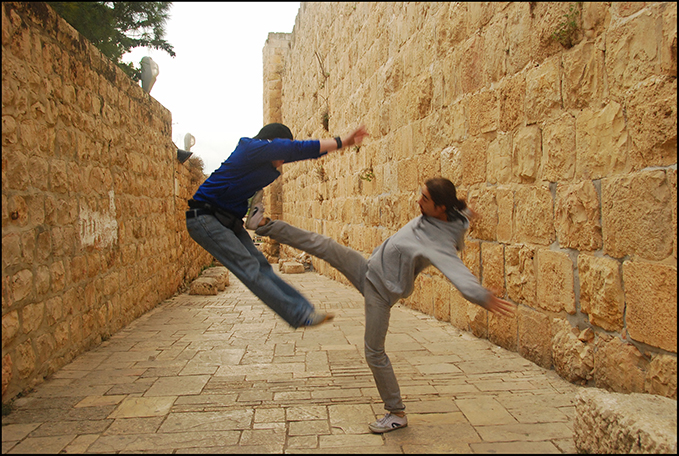
The dynamism in focus – two human bodies in gravity defying action – is a counterpoint to the sombre stability established by the vast architectural planes that form the threshold of the image. The frame employs perspective, but as a device to accentuate the drama in focus, rather than to depict depth. The eccentric symmetries about the vertical and horizontal axes too serve the animated focus.
This appears to be the only choreographed frame, wherein the subjects’ composition and state are either directed by the photographer, or there is a consent between the framer and the framed regarding the timing and disposition.
The texture of stone on the floor and in the walls, along with its perspectival extension into infinity, offers an intriguing and playful geometric/ organic dichotomy. Though the action and the context of the photograph are alien to me, and the light is not dramatic either, the humour in its buoyancy and the texture of the architectural forms keep me excited and engaged.
Perspective and fading light (though there is a hint of the horizontal ceiling plane) create the spatiality in this photograph of a wall. Another plane seen through the doorway adds to this spatiality. The image, symmetrical about the vertical axis, derives its structure from the rhythm of the vertical architectural elements.
The primary focus is the blue patch of a world map, while the number ‘49’ in red on the plane behind forms the secondary focus, both immersed in pale coloured planes
The tilted map, located eccentrically above the centre, the hint of the ceiling and absence of the floor plane, and the ‘flash’ light lend buoyancy to the image.
The script on the map and, to some extent the geometric pattern on the laminated board visible from the doorway, suggest the cultural moorings of the subject: possibly a Muslim/ Bohra household – a minority community in my political context.
The construction system of the house – timber posts and beams, brick-masonry infill walls, and stone slab floors – is traditional and indicative of communal living; yet again, a fading form in contemporary society. These represented vulnerabilities lend a melancholic character to the image. However, the forced light, which almost washes away the tactility of the walls, keeps the image from becoming poignant.
image 02.
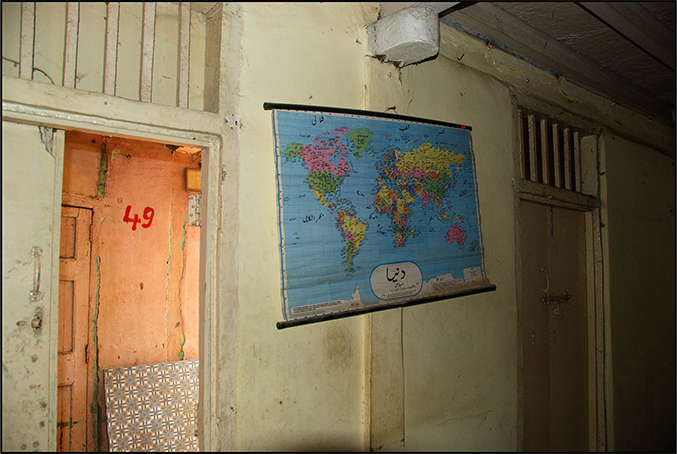
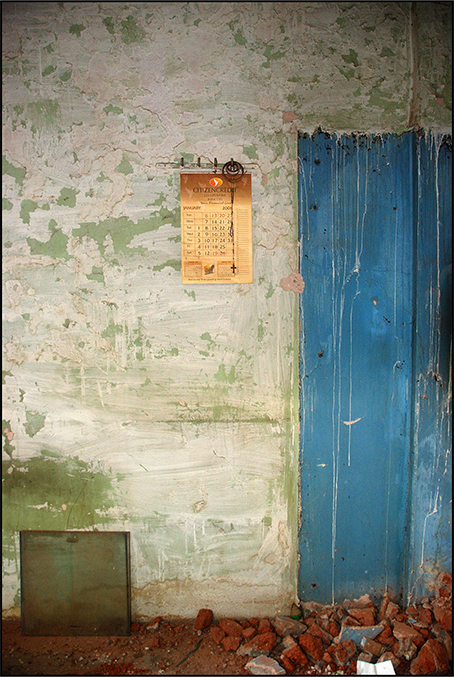
image 03.
A very graphic, near abstract, non-perspectival image with three eccentric foci – the large blue rectangle, the small copper rectangle and the small green square – located on a plane of pale coloured wall, textured by peeling. In spite of their static condition, the disproportion in the geometric forms and their disposition set my eyes in motion, fumbling to find stability. The frame instigates animation in engagement.
Two creases – one horizontal, running close to the bottom edge of the image and the other vertical, running close to the right edge – suggest spatiality in the photograph almost unspokenly. The green square crossing over the horizontal crease, the gradient in the calendar’s shine and the rubble on the thin ground-plane at the bottom (offering a counterpoint to the strong geometric forms) add to the subtle spatiality. Thus, the frame offers an intriguing transition from graphic to spatial and back.
However, once the spatiality is registered, what is also revealed is that the subject was a household, and what is represented is a trace of life that was. On closer inspection of the object overlaid on the calendar it comes to notice that a cross pendant hangs from a beaded necklace. ‘Christian,’ ‘faith,’ ‘solitude,’ and ‘minority’ come to mind. This is a dichotomous frame of graphical humour and spatial melancholy. However, had the light been such that the ground-plane and rubble were darker, it would, perhaps, have offered the image some counterpoint in weight to make it poignant.
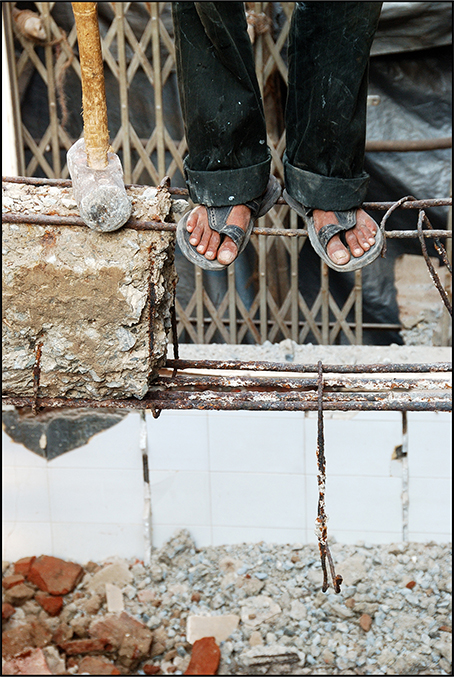
Image 04.
This is an anti-gravitational composition with mass above and void below, adding further humour to the frame is the position of the labourer – standing on thin steel bars, counter-balanced by the mass of concrete on the partially demolished beam. The image is structured by strong horizontal and vertical lines, and, in the background, criss-crosses and a faint trace of a grid in the lower portion. Rubble, again, forms a counterpoint to geometry. Besides the presented economic process and the possible deliberation on the social context of the labourer, owing to the passive quality of light, I fall short of engaging further with photograph. If the focus (the labourer on the partially demolished beam) were to be blurred and the background texture presented in clarity, it would have, perhaps, prolonged my engagement with the image.
This is an anti-gravitational composition with mass above and void below, adding further humour to the frame is the position of the labourer – standing on thin steel bars, counter-balanced by the mass of concrete on the partially demolished beam. The image is structured by strong horizontal and vertical lines, and, in the background, criss-crosses and a faint trace of a grid in the lower portion. Rubble, again, forms a counterpoint to geometry. Besides the presented economic process and the possible deliberation on the social context of the labourer, owing to the passive quality of light, I fall short of engaging further with photograph. If the focus (the labourer on the partially demolished beam) were to be blurred and the background texture presented in clarity, it would have, perhaps, prolonged my engagement with the image.
Image 05.
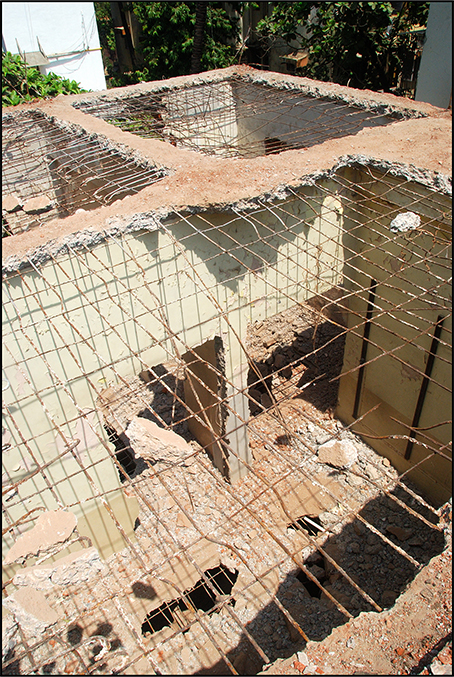
This image attempts to achieve symmetry using perspective to create a rhombus by aligning a pair of its diagonal vertices and a thin face of a wall below along the vertical axis of the frame. While the wall profile one room forming this rhombus if located in the upper half, the void of another room is counter-positioned in the bottom half. Yet again, a geometric/ organic dichotomy is at play as the rubble counterpoints the geometric mesh and planes.
The frame offers an opportunity of engaging honeycomb spatiality, which is left incomplete due to inappropriate conditions of light and shadow, and what it evokes in me is only some buoyancy.
A dramatic frame representing beauty in destruction; it is structured on the symmetrical opposition of mass and void: debris in one half and dust in the other.
This frame of violent animation also employs the counter-play of the geometrical crane-arm dividing the amorphous dust cloud and debris.
Though the quality of light isn’t critical to this image, but its texture concealed and revealed by the dust lends this photograph its emotive qualities. The intimidating scale of this destabilizing event adds to the awe produced by the image.
image 06.
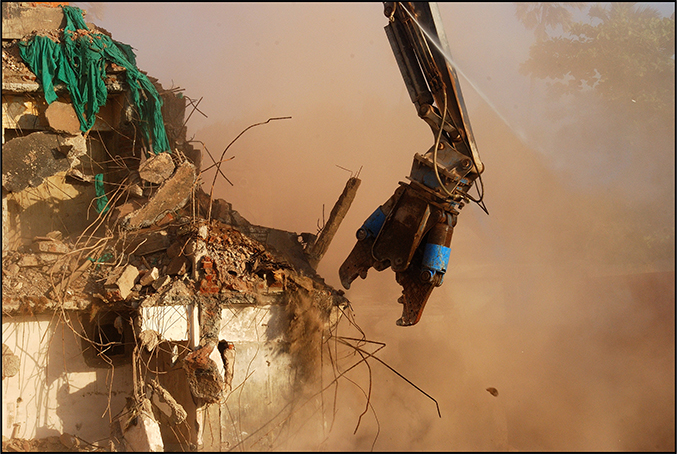
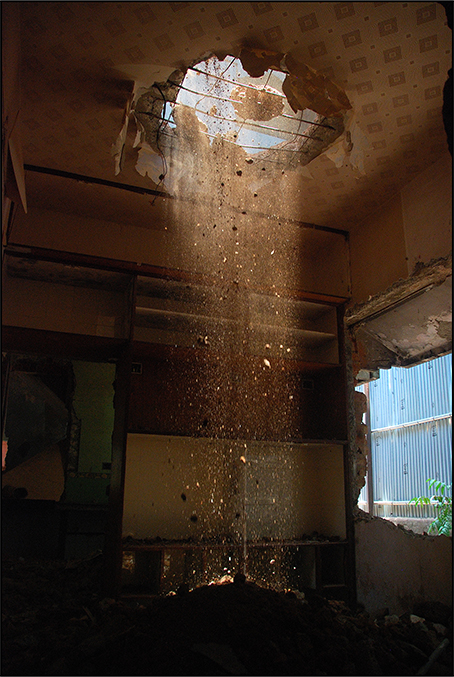
image 07.
By far this is the most dramatic image in the selection, primarily due to its recording through light – illumination, shadow and darkness; texture and colour. Structured around the cascading debris and light, this spatial image contains diagonal (top-right/ bottom-left) as well as vertical symmetries, with openings located on either sides of the axes. The strong planes and lines are countered by rubble and rough-edges of the apertures. There is also layering involved with surfaces visible beyond the apertures.
The broken wardrobe and the pattern on the ceiling evoke reminiscence, while a broken piece of mirror on the left evokes intrigue (is there a glimpse of the photographer?). The image is magical.
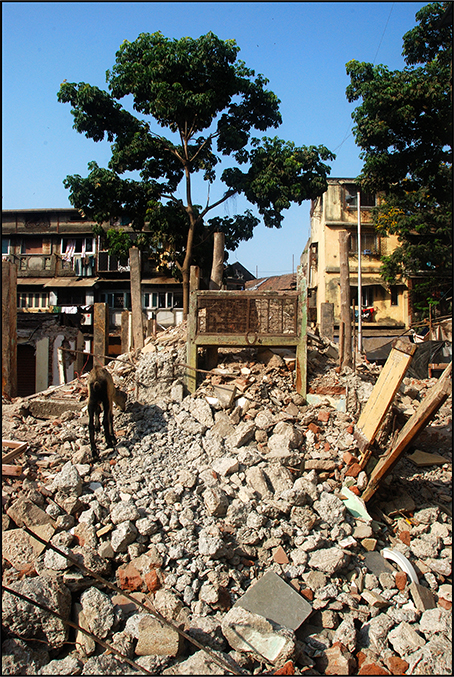
Image 08.
One of the most engaging compositions of the set, this image is structured on symmetries about the horizontal and vertical axes, with a very strong geometric focus, and anchored by architectural elements and edifices. While two building masses are positioned on either side of the vertical axis, the symmetry about the horizontal axis concerns with the counter balance of mass and void: debris cascading from the rectangle in the centre, and the sky streams from it above – the branching tree accentuating this flow. Yet again, geometric forms (architectural elements) are counter-positioned with organic ones (rubble and foliage).
The tree located eccentrically to the vertical axis instigates me to shift it back to the centre making the engagement dynamic.
The image evokes sadness and apprehension owing to the evident destruction of a socio-economic fabric and the impending replacement. Though the image holds me in suspense, the merely supportive light and an uncooperative goat limit the frame short of its potential.
image 09.

This is the only frame in the set which focuses on an object surrounded by a monotonous threshold of texture.
Symmetrical about the horizontal, vertical and diagonal axes, the image is structured by the steel rods that hold the mass of fabric (bedrolls perhaps), displacing balancing space around.
Though light is only incidental, the state and composition of the frame keep me engaged with the intimidating but necessary question: ‘what is essential?’
This frame employs juxtaposition to defy perspective and over-riding structure. The plane of steel grid in the foreground contends the rectangle’s perspective in the perpendicular plane behind, while the randomly lying brick-bats contend the geometry of the grid.
Light again is not emotive, but a household image of deities on a wall, framed though the demolished roof presents irony.
On closer inspection, drawn on the wall, besides some jottings, are some graphite arcs (below the poster) – markers of childhood. Irony then is compounded with nostalgia and evokes melancholy, but the photograph is still not poignant.
image 10.

Image 11.
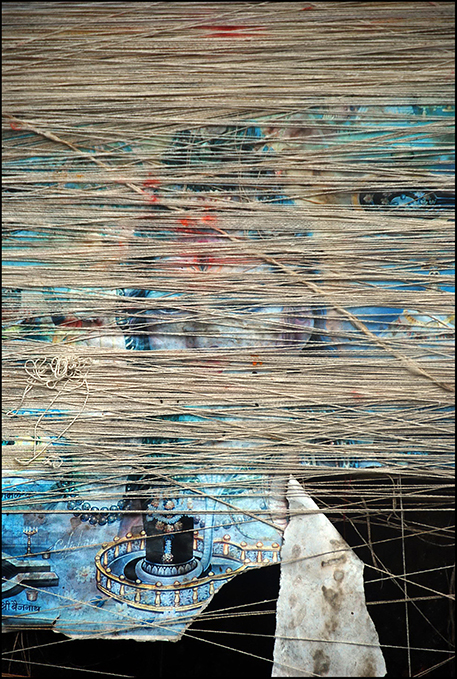
This image lives by the strength of its texture; its structure as well as its threshold is the striations of thread running horizontally across. Interestingly though, the focus is the obscure form beyond the veil which my eyes unrelentingly grope to complete. A diagonal strand of thread is the other distraction that leads the eyes across the image, and the amorphous darkness at the bottom adds a third catalyst for animation.
It is severely ironical that a religious image, wrapped in intense faith is also vulnerable, not unlike people and their other constructs. And, beyond the torn edge of the image is unfathomable darkness. This is poignant.
summary
Barring images 01., 02., and 11. demolition, or, in a general perspective, construction processes form the socio-economic context of all photographs. Though image 09. does not offer any direct indication of such a context, the things themselves and the compactness of their arrangement suggest a nomadic way of life with minimal belongings and hence, likely to belong to construction labourer[s].
I am familiar with the cultural contexts of all frames, which form part of the communally diverse, urban/ sub-urban environments I live in; except image 01., which interests me for its representation of architecture and animation. If all the images were to be accorded a single theme, it will be the inevitable aspect of life called violence.
Each of the frames deals in different degrees with factors intrinsically related to violence: anchors, displacement and reconciliation. In fact, it is displacement – of expectations, of structures, of people, of beliefs and so on – depending on its nature and degree, evokes corresponding cerebral, emotive and physical reactions. Displacement forms the bedrock of our engagement with the world around.
Subsequently, creative pursuits too displace what exists in a given environment when they frame to select (and de-select). It is this choice of displace that I have attempted to scrutinize through the triangular framework of composition, state and light.
The composition and state in all the frames are engaging; employing shifting symmetries and dichotomies of mass/ void, geometric/ organic, anchor/ displacement and so on. However, such is not the case as far as light is concerned. Only images 06., 07. and 11. Critically depend on light, for the rest light is only incidental or supportive at best. Even though it could be the limitation that the photographer found herself in at the moment of framing, since photography is about light, I find the passive quality of light in most frames a shortcoming in the photographs’ potential of transcending the documentational mandate.

 malkum
malkum